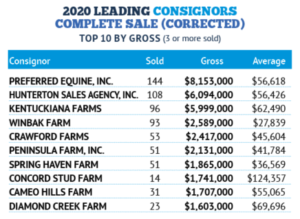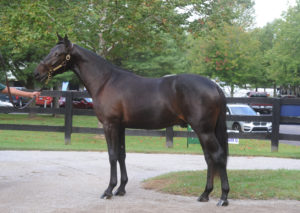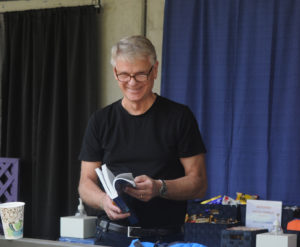Lexington smashes all-time records for gross and average
The opening session of the 2021 Lexington Selected Yearling Sale set new high-water marks by grossing over $18.5 million, averaging $161,217 and selling 69 six-figure yearlings. The average was up 25 per cent and the gross climbed 22 per cent compared to 2020. This year’s first session was even stronger than the previous best 2019 opener when two million-dollar yearlings were sold.
quotes by James Platz / story by Dave Briggs
Tuesday’s opening session of the Lexington Selected Yearling Sale at the Fasig-Tipton sales pavilion in Lexington, KY set new records for gross ($18,540,000) and average ($161,217) even compared to the gangbuster 2019 sale that saw two million-dollar yearlings sell on opening night. When it comes to the median of $105,000, the opener was better than the $100,000 median in 2020, but third best in sale history behind 2018 ($120,000) and 2019 ($110,000).
In all, a record 69 yearlings sold for $100,000 or more Tuesday night, including 30 that sold for $200,000 or higher, 16 that sold for $300,000 or more and 11 that sold for $400,000 or higher.
The number of $100,000 yearlings was up from 60 in 2020, 68 in 2019, 64 in 2018 and 54 in 2017.
The session concluded at 11:15 p.m.
“From a historical point of view very gratifying, very satisfying,” said sale co-manager David Reid. “A shout out goes to the breeders and the farms that raise these horses and presented them.
“There were very strong pacing fillies on the high end. There were very strong trotting fillies high end. The trotting colts were very good and the pacing colts sold well, so, there again… cumulatively it was a very good night.”
Fillies dominated the night. Trotting fillies led the way by averaging $191,750, followed by pacing fillies ($191,588), trotting colts ($143,775) and pacing colts ($119,500).
“The list of buyers was very healthy,” Reid said. “I thought it was a wide diversity of those. You see some new names on there. It’s not all the super trainers and I think that shows a good sign and diversity and I think it’s a good way to start off the week. It should trickle down on through the week and there’s a lot of good horses left to sell.
“I also think tonight you’re dealing with pedigrees and individuals that are going to be potential stallion prospects or future breeding prospects down the road. The residual value when it comes to filles – trotters or pacers – the people buy them realize that and that’s what helps to strengthen the market.”
Tuesday’s average of $161,217 was up 25 per cent from the 2020 pandemic-sale average of $129,127 and 4.5 per cent from the 2019 average of $154,288. This year’s opening-session gross of $18,540,000 was up 22 per cent from the 2020 gross of $15,237,000 and up 1.8 per cent from the 2019 gross of $18,206,000.
This year, 115 yearlings were sold on opening night. In both 2020 and 2019, 118 yearlings were sold.
HUNTERTON LEADING CONSIGNOR
“If you look at the USTA website it’ll tell you that the purses from this year versus last year with the pandemic is $100 million more and our business is that way – money in, money out,” said Steve Stewart of Hunterton who led all consignors in gross sales. Hunterton sold 17 yearlings and earned $3,592,000 on the night. Hanover Shoe Farms was second with $2,675,000 in gross sales for 15 yearlings.
“I can’t speak for other people, but we were really rewarded. What’s interesting… for example, number 92 [Kygo], we bought the mare from White Birch [My Little Dragon] for $230,000 and she was 15 years old. She’s a champion and everybody said, ‘Oh my gosh, that’s a lot of money for an older mare’ but then she sells her filly for $340,000,” Stewart said. “Steve Jones paid $425,000 for (Come See The Show, the dam of) Hip 42 [Stop The Show] and got $400,000 back… A lot of people wonder why we sell our fillies, but we sell our fillies so we can go buy factories and that’s what we’ve been doing for the past 10 years. We take our yearling money and go buy factories and we keep doing that. The future is very bright.”
TAKTER’S SALE TOPPER
The session topper was hip 62 Exile, a Walner filly out of Swan Hot Mama purchased for $800,000 by Nancy Takter, agent, from the Diamond Creek consignment.
“She’s a beautiful filly,” Takter said. “It’s a really good family and Walner is obviously a hot stallion. Her sister (Altar) is the fastest 3-year-old filly this year (1:50.3), which I train… and she reminds me a lot of her sister. So, hopefully, she has her sister’s speed and we’ll go from there.”
Diamond Creek owner Adam Bowden said he thought Exile was, “the right horse, from the right family, on the right night, but I don’t know that I ever expected to get that kind of money. That was cool.”
Diamond Creek was the third leading consignors in average (with 3 or more yearlings sold). The farm averaged $217,143 for seven yearlings sold to finish behind Concord Stud ($226,000 average for five sold) and Cameo Hills ($219,571 for seven sold) on the night.
“We were really happy with all the other ones (Diamond Creek sold),” Bowden said. “We got what we thought we were supposed to get for the horses that we brought and the sale is strong, so we’re very happy.”
Bowden said Diamond Creek will buy back into Exile’s ownership.
“Why wouldn’t I? She’s a beautiful filly and we went back and forth about selling her in the spring. We had had three fillies before her and I have a couple of fillies behind this one. We took a chance that Walner was going to be hot and we guessed right,” Bowden said. “She ends up in the right hands. We love Nancy, so there was no reason not to keep a piece of her.”
Takter also purchased When Dovescry’s full-brother hip 32 Cypress Hanover (Muscle Hill—Cedar Dove) for $475,000 from Hanover Shoe Farms.
“Nice colt. Obviously, really good pedigree and really great video that, you know, caught our eyes. We thought we’d give him a run. Now, $475,000 is obviously a lot of money, but I thought that was very well-priced for him, so I’m happy with that,” Takter said, adding the dual-eligible to Kentucky horses were earning a premium.
“People are paying good money for the dual-eligible horses,” Takter said. “Both of those horses that I bought are dual eligible so they have a lot of earning potential next year. They can race in their regional Sires Stakes programs in New Jersey Sires Stakes and then they could go on and race in Kentucky. You really don’t have to go much further – you can race in your regional Sires Stakes and then come to Kentucky and hopefully to the Breeders Crown and maybe a Final Four race after that.
“When I went through the catalogue, obviously I only have so much time to look at yearlings and we try to do the best we can. If the horses weren’t dual eligible, unless they had a fabulous dam on them, they might not have gotten looked at.”
Bowden said, “The amount of money that Kentucky is going to pour into this sport in the Sires Stakes is huge and I think it’s the safety net that the buyers need. The breeders are being rewarded for it tonight.”
Takter led all buyers in gross purchases with exactly $1.5 million spent on four yearlings. She also bought Greenshoe’s full-brother, hip 97 The Big Valley, a Father Patrick colt out of Designed To Be, for $140,000 from Kentuckiana Farms. The Big Valley is also a full-brother to Maverick, the yearling that set a record for a standardbred yearling sold at auction when he was purchased for $1.1 million at the 2019 Lexington Selected Yearling Sale.
Takter also purchased hip 104 Rackuencourt, a Tactical Landing colt out of Sarcy bought for $85,000 from Hunterton and her final purchase of the night was hip 112 Sergio Hanover, a Muscle Hill colt out of Spring Gala she bought for $165,000 from Hanover Shoe Farms.
GIMPANZEE’S SISTER FOR $750,000
The second highest priced yearling sold Tuesday came four horses from the end of the session when Gimpanzee’s full-sister, hip 113 Mandrill, sold to Gimpanzee’s trainer, Marcus Melander — agent for Gimpanzee’s co-owner SRF Stable of Sweden — for $750,000 from the Concord Stud consignment on behalf of breeder Stefan Balazsi.
“Just because they have the pedigree and a good video, they have to actually look good, too. She really did, so we’re very excited to bring her home,” Melander said. “She’s just got everything… What’s not to like about her?”
Melander said he knew Mandrill was going to be expensive. He had SRF’s Lennart Agren with him while bidding.
“We weren’t really sure when to stop, so you kind of had to feel it. That’s why I had him right with me all the time. We kind of knew after tonight that it was going to be pretty expensive. We knew it would be in that kind of range, so we were expecting it,” Melander said.
Concord’s Julie Meirs said she, “got a little nervous when they took a $5,000 bid. I think it was about at $400,000, but it was a lot of fun. There was a lot of action. It wasn’t just the two battling it out until right at the end. We had been getting great feedback from a lot of top prospective buyers. It wasn’t clear who was going to end up on top at the end. It could’ve gone multiple different ways.
“With this particular filly, she wasn’t Kentucky eligible. So, it’s wonderful for the industry, but it also shows you that you can bring something in here that’s not Kentucky and still do okay.”
JACOBS GETS WALNER FOR $620,000
Ken Jacobs, who owned Walner and syndicated him to stand stud, purchased hip 54 Earthquake Bi, a Walner colt out of Dream Child for the third highest price of $620,000 from Hunterton Sales Agency Inc., agent.
Jacobs said Earthquake Bi was “number one” on his list.
“I wanted to go home with it,” he said. “There’s other (Walners) that are nice. He stamps them pretty good, but… there’s a certain thing I like and it’s got to be a racey-looking trotter and that’s really what I look for.
“The video was unbelievable and the conformation was perfect. There’s nothing that I didn’t like about it. The Walners… I have to honor his product so to speak.
“I had two people saying that I wasn’t going to get it… they must’ve been the underbidders.”
Jacobs said he thought Earthquake Bi would go for around $500,000.
“I knew several were going to go to $400,000 and usually people get caught up and they overbid, so I knew it was at least going to $500,000,” he said.
Jacobs said he will give the colt to Tony Alagna to train.
“He knew I was going to take a Walner home. I just didn’t want to step on his toes, because I told him that I wasn’t going to stop (bidding),” Jacobs said.
Ron Burke spent $800,000, total, to collar six yearlings, including $175,000 spent to collar the full-sister to his trainee and 2017 Horse of the Year Hannelore Hanover (hip 73 Hanna Too Hanover) from the Hanover Shoe Farms consignment.
Burke said his strategy was to, “just get the best horse you can for the money. There was a great consignment this year because the first day is really strong and we don’t want to not get something, so we’ve tried to use caution and buy in the right spots. I think, a couple, we did really well on price… you always think you did well right now. We’ll know next year if we did well or did terrible. I’m very happy with what I got.”
Burke said his two favorite purchases were hip 59 Point Of Perfect, a Walner colt out of Falling In Love from Hunterton for $205,000 and hip 42 Stop The Show a Sweet Lou filly out of Come See The Show for $400,000 from Cameo Hills.
“Number 59, I loved him and I thought he’d bring more. It’s out of a sister to Southwind Frank and those are two horses that I had… great in the paddock, good individual,” Burke said. “Obviously, the Sweet Lou for $400,000 was a stretch to go get her, but a lot of people thought she was the best filly in the sale… and out of a champion mare.”
KY DUAL-ELIGIBLES HOT
Burke said increases to both the Kentucky and New Jersey sires stakes programs was particularly attractive.
“You never have to leave a mile track and basically not stake in anything but Sires Stakes and then pick up with the Grand Circuit here and that’s it. You’ll have more than enough racing,” Burke said of being able to race at the Red Mile in Kentucky and The Meadowlands in New Jersey.
“With New Jersey being stronger in its own right it’s looking good,” he said. “There’s going to be more money and the same amount of horses. Theoretically, if you’ve been making money then you should make more money. We’ve had a good run and we’ll reinvest. These people in Kentucky, they’ve stuck through it and they are getting paid for it now.”
Owner David McDuffee agreed the enhanced Kentucky program was particularly attractive and said it is “an unbelievably good sale” so far. “Obviously, anything that’s got Kentucky breeding into it is selling for 25 per cent more than it would’ve without it,” he said. “The pacing fillies are the shocker to me. It wasn’t too many years ago that you couldn’t give away a pacing filly and now, my God, they are bringing $400,000.”
McDuffee purchased hip 35, Blonde Bombshell for $400,000 and hip 40 Andy Mac Hanover for $295,000.
“I struck out on a couple, so I didn’t get them all,” he said.
“I bought (Blonde Bombshell out of) Hey Blondie, who I had ownership in at one time. I had sold my portion to Steve Jones, but she’s a Walner. I believe, had she been dual eligible, she probably would’ve brought another $150,000. That’s just the way it’s been all night, but I’m pretty happy to have her. In fact, I’m thrilled to have her.
“The pacing colt is a Captaintreacherous from Hanover. It’s a great-looking individual and he sold for about what I thought he’d sell for.”
McDuffee, the part-owner of undefeated 2-year-old trotting filly Venerable, winner of the Mohawk Million, said there’s a lot of opportunity for horse owners now.
“We’re racing for a lot of money and these Sires Stakes programs are getting better everywhere,” McDuffee said. “You can make money in this business and that’s not like some other businesses right now. We’re in pretty good shape, I think.
Tonight’s (Oct. 6) second session of the Lexington Selected Yearling Sale will feature some 220 yearlings. It begins at 3 p.m. at Fasig-Tipton. For more information about the sale, please visit: http://www.lexingtonselected.com
CORRECTION
In our Monday, Oct. 4 Lexington sale preview issue, on pg 23 we ran an incorrect chart of 2020 sale consignors by gross sales.




















